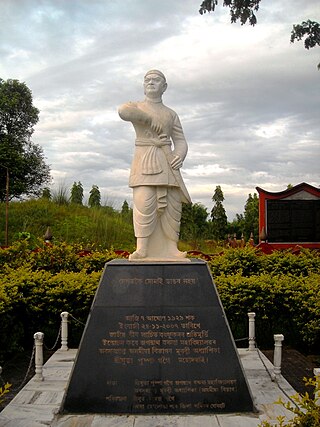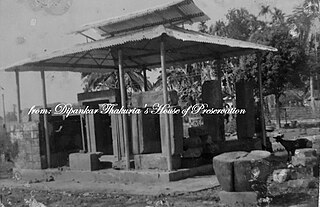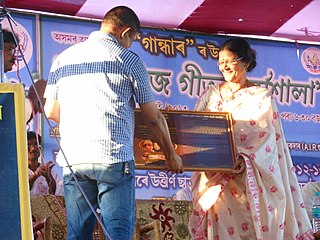
Kamarupi Prakrit is the postulated Middle Indo-Aryan (MIA) Prakrit language used in ancient Kamarupa. This language is the historical ancestor of the Kamatapuri lects and the modern Assamese language; and can be dated prior to 1250 CE, when the proto-Kamta language, the parent of the Kamatapuri lects, began to develop. Though not substantially proven, the existence of the language that predated the Kamatapuri lects and modern Assamese is widely believed to be descended from it.

Lachit Borphukan was an Ahom Borphukan, primarily known for commanding the Ahom Army and the victory in the Battle of Saraighat (1671) that thwarted an invasion by the vastly superior Mughal Forces under the command of Ramsingh I. He died about a year later in April 1672.

The Kamakhya Temple at Nilachal hills in Guwahati, Assam is one of the oldest and most revered centres of Tantric practices, dedicated to the goddess Kamakhya. The temple is the center of the Kulachara Tantra Marga and the site of the Ambubachi Mela, an annual festival that celebrates the menstruation of the goddess. Structurally, the temple is dated to the 8th-9th century with many subsequent rebuildings—and the final hybrid architecture defines a local style called Nilachal. It is also one among the oldest 4 of the 51 pithas in the Shakta tradition. An obscure place of worship for much of history it became an important pilgrimage destination, especially for those from Bengal, in the 19th century during colonial rule.

Nalbari is an administrative district in the state of Assam in India. The district headquarters is located at Nalbari. The district derives its name from the combination of two words, "Nal" and "Bar."

Barpeta is a town in Barpeta district of the state of Assam in India and is district headquarters. The city is located 90 kilometres (56 mi) north west of Guwahati and is one of the major cities in Western Assam. It is also called Satra Nagari of Assam due to the presence of various Vaishnavite Satras in the vicinity.
Though the precise Etymology of Assam, a state in India is unclear—there is general agreement that it is related to the Ahom people. Whatever the source of the English name, Assam is itself an anglicization.

Chand Sadagar was a rich and powerful sea merchant of Champaknagar in Eastern India. This merchant has been claimed by both the Assamese and Bengali people of India to be associated with their respective states and communities. Medieval Bengali poet Bipradas Pipilai mentioned in his "Manasamangal Kāvya" that merchant ship of Chand Sadagar used to proceed to the sea from ancient Champaknagar of Kamarupa after passing through Tribeni, situated at the junction of Saptagram and the confluence of Ganges, Saraswati and Jamuna River of modern-day West Bengal. Narayan Dev in the Assamese scriptures gave an account in his Manasamangal about the merchant ship of the trader Chand Saudagar proceeding to the sea from ancient Champaknagar of Assam passing through Saptagram and Tribeni, the tri-junction of the Ganges, Saraswati and Jamuna River. In the Padmapuran, account of Chand Bania (Sadagar) is specifically mentioned.
Kamrupi literature is the literature written in the modern Kamrupi dialects of Assamese language.
Chaygaon is a town in Kamrup district of Assam, India; situated on the south bank of the Brahmaputra river. It is 38 km from major town Guwahati. The town is known for "Maa Chandika Devalaya", a Shakti Peeth, where thousands of devotees visit during Durga Puja. Historical "Mer Ghar" of Chand Sadagar situated in Champak Nagar, Chaygaon.

Kamarupa was a kingdom in Northeast India that was ruled by three dynasties from their capitals in Pragjyotishpura, Haruppeshwara, and Durjaya. The kingdom was known for its power and influence in the region.

Kamrupi dialects are a group of regional dialects of Assamese, spoken in the Kamrup region. It formerly enjoyed prestige status. It is one of two western dialect groups of the Assamese language, the other being Goalpariya. Kamrupi is heterogeneous with three subdialects— Barpetia dialect, Nalbariya dialect and Palasbaria dialect.

Kamrup is the modern region situated between two rivers, the Manas and the Barnadi in Western Assam, with the same territorial extent as the Colonial and post-Colonial "Undivided Kamrup district". It was the capital region of two of the three dynasties of Kamarupa and Guwahati, the current political center of Assam, is situated here. It is characterized by its cultural artifacts.

Kamarupi script was the script used in ancient Kamarupa from as early as 5th century to 13th century, from which the modern Assamese script eventually evolved. In the development of the Assamese script, this phase was followed by the medieval and then by the modern Assamese scripts.
Domahi, or Domasi and Damhi, is a popular harvesting festival, celebrated in the Kamrup and eastern Goalpara regions of Western Assam. It marks the commencement and end of the harvesting season, and start and end of the Kamrupi and Goalpariya new years.
Assam – 16th largest, 15th most populous and 26th most literate state of the 28 states of the democratic Republic of India. Assam is at 14th position in life expectancy and 8th in female-to-male sex ratio. Assam is the 21st most media exposed states in India. The Economy of Assam is largely agriculture based with 69% of the population engaged in it. Growth rate of Assam's income has not kept pace with that of India's during the Post-British Era; differences increased rapidly since the 1970s. While the Indian economy grew at 6 percent per annum over the period of 1981 to 2000, the same of Assam's grew only by 3.3 percent.

Anima Choudhury is a singer from the Indian north eastern state of Assam. Her musical career over more than four decades has focussed on folk and modern Assamese songs. She has been awarded local and state level musical and cultural recognitions and titles including. "Luit Kuwari", and "Jan Dimali". Some of her most popular songs are 'Dikhou noir parore', 'Log diyar kotha asil' and 'E pran gopal'.
Sonkuriha, 'Suvarnakundya' in ancient times, is a village in Nalbari district of Western Assam.
The Brittial Bania/Bania is an ethnic community in Assam, India. The group traces its roots to a merchant community who reached Assam in ancient times. Some historians claim that after the Austric group migrated to ancient Assam, the next group of people who arrived was the Dravidian group, who are represented by the Bania and Kaibbartas today. Unlike the mainland Baniya community, this community of Assam is recognized as Schedule Caste by the government of India.
Haribhanga is an agricultural village of Nalbari district in Western Assam under 45 No. Paschim Nambarbhag Gram Panchayat. Eighty percent of the population of this village depends on agriculture for their livelihood. For the development of economic, social, political, art and culture of the greater Haribhanga area, the Haribhanga Gaon Unnayan Sammittee was formed in. 1945. The most renowned, historical and religious holy place of Haribhanga is the Kaliya Gosai Mandir.
Rajen Sharma, commonly known as Uddipta Hazarika, was the first publicity secretary of the militant organisation United Liberation Front of Asom (ULFA). Popular for his poem Mor Rakta Borna Protigya, Sharma was killed on 8 October 1989.













